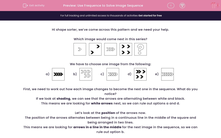Hi shape sorter, we’ve come across this pattern and we need your help.
Which image would come next in this series?
-25(1).png)
We have to choose one image from the following:
a) -26(1).png) b)
b) -27.png) c)
c) -28.png) d)
d) -29.png) e)
e) -30.png)
First, we need to work out how each image changes to become the next one in the sequence. What do you notice?
If we look at shading, we can see that the arrows are alternating between white and black.
This means we are looking for white arrows next, so we can rule out options a and d.
Let’s look at the position of the arrows now.
The position of the arrows alternates between being in a continuous line in the middle of the square and being arranged in two lines.
This means we are looking for arrows in a line in the middle for the next image in the sequence, so we can rule out option b.
Now, let’s look at number or frequency. Is there anything we can count?
The number of arrows is increasing by one each time.
This means we are looking for 5 arrows for the next image in the sequence, so we can rule out option c.
If we bring this all together, we are left with option e as our correct answer.
Let’s try another one:
Which image would complete this sequence?
Notice that this time the missing image is in the middle of the sequence.
-31(2).png)
We must choose one image from the following:
a) -32.png) b)
b) -33(1).png) c)
c) -34.png) d)
d) -35(1).png) e)
e) -36(1).png)
First, we need to work out how each image changes to become the next one in the sequence.
If we look at the lines on each smiley face, they are alternating between dashed lines and solid lines.
Therefore, the missing image should have solid lines, so we can rule out options b, d and e.
Is there anything we can count?
We can count the sides of each of the shapes in the bottom right corners. Image 1 has a 3-sided triangle, image 2 has a 4-sided square, image 4 has a 6-sided hexagon and image 5 has a 7-sided heptagon.
This means that the number of sides of the bottom right corner shape are increasing by one each time.
If image 2 has a square, we know that image 3 needs to have a 5-sided pentagon, which rules out option a so we are left with c as our correct answer.
(1).png) |
Pssstt! Here's a handy hint to help you reach superstar status: Look for alternating patterns and changes in lines, shading, position and frequency. |
It’s now your turn to find the missing image in the series.
Good luck!







